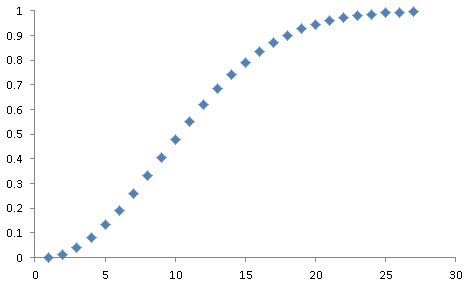Today, some of us were playing a game. Everyone contributed to the creation of a bank of questions which included “What kind of music do you like to listen to?” and “What is the strangest thing that you have eaten?”. A script was created to draw from a total of 72 unique questions at random with replacement and no option would be given to pass on questions. The idea was that we would take turns on our birthdays to answer these questions in an up close and personal session. Of course, there was the issue of how many questions one should have to answer. So when we had our first volunteer today, we decided to make things interesting, two choices were given.
(A) Keep answering questions until a duplicate question was drawn.
(B) Stop at a fixed number of 20 questions.
The volunteer picked (B). Was this the right choice from the perspective of minimizing the number of questions one had to answer?
Let’s see what choice (A) entails. Given x questions drawn randomly, let the probability of no duplicates within these x draws be denoted by ‘A’. Then
 From this graph, you will notice that once past question 10, there is a better chance than a coin toss of drawing a duplicate question. By question 18, that chance rises past 90%. Thus, from the perspective of minimizing questions, it would actually make sense to go with option (A).
From this graph, you will notice that once past question 10, there is a better chance than a coin toss of drawing a duplicate question. By question 18, that chance rises past 90%. Thus, from the perspective of minimizing questions, it would actually make sense to go with option (A).
BUT WAIT! If one looks carefully at this example, one might notice that we have essentially recapitulated a very famous problem called the Birthday Paradox. This concerns the scenario where you have a group of people in the room and you want to figure out the chance of at least two people having the same birthday.
Our prior example is formally equivalent to the birthday problem. Instead of questions, we have days of the year. Instead of number of questions drawn, we have number of people. So all we have to do is take our equation above and substituting N = 365, we can obtain the very same plot.

You may not have been expecting this result, but with a group of 23 people, the chance of any two sharing the same birthday is a coin toss. Raise that number to 41 people and you have a 90% chance!
Not that this is anything new, but it was nice to rediscover this principle through our little Q&A game.

